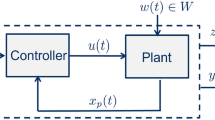Abstract
This paper presents a novel adaptive reference governor for robust tracking control in constrained linear systems with bounded disturbances. The proposed reference governor achieves a performance improvement over the existing reference governors by virtue of its added feature: adaptability. The design of such an adaptive reference governor involves a nonlinear non-deterministic polynomial time (NP)-hard optimization problem because the solution of the optimization problem must be searched for the infinite number of sequences of disturbance. The SDP relaxation method turns out to allow the nonlinear NP-hard problem to be recast into an SDP, which may be readily solved in polynomial time.
Similar content being viewed by others
References
D. S. Bernstein and A. N. Michel, A chronological bibliography on saturating actuators, International Journal of Robust and Nonlinear Control, 5 (5) (1995) 375–380.
A. Bemporad, A. Casavola and E. Mosca, Nonlinear control of constrained linear systems via predictive reference management, IEEE transactions on Automatic Control, 42 (3) (1997) 340–349.
A. Bemporad and E. Mosca, Fulling hard constraints in uncertain linear systems by reference managing, Automatica, 34 (4) (1998) 451–461.
A. Bemporad and A. Garulli, Output-feedback predictive control of constrained linear systems via setmembership state estimation, International Journal of Control, 73 (8) (2000) 655–665.
S. Boyd, L. El Ghaoui, E. Feron and V. Balakrishnan, Linear Matrix Inequalities in System and Control Theory, SIAM Studies in Applied Mathematics, Philadelphia, USA (1994).
S. Burer and R. Monterio, A projected gradient algorithm for solving the maxcut SDP relaxation, Optimization methods and Software, 15 (3) (2001) 175–200.
A. Casavola, E. Mosca and D. Angeli, Robust command governors for constrained linear systems, IEEE transactions on Automatic Control, 45 (11) (2000) 2071–2077.
M. K. H. Fan, A. L. Tits and J. C. Doyle, Robustness in the presence of mixed parametric uncertainty and unmodeled dynamics, IEEE Transactions on Automatic Control, 36 (10) (1991) 25–38.
E. G. Gilbert and I. Kolmanovsky, Fast reference governors for systems with state and control constraints and disturbance inputs, International Journal of Robust and Nonlinear Control, 9 (15) (1999) 1117–1141.
E. G. Gilbert and I. Kolmanovsky, Nonlinear tracking control in the presence of state and control constraints: a generalized reference governor, Automatica, 38 (12) (2002) 2063–2073.
J. R. Gossner, B. Kouvaritakis and J. A. Rossiter, Stable generalized predictive control with constraints and bounded disturbances, Automatica, 33 (4) (1997) 551–568.
Y. I. Lee and B. Kouvaritakis, Robust receding horizon predictive control for systems with uncertain dynamics and input saturation, Automatica, 36 (10) (2000) 1497–1504.
Y. I. Lee, B. Kouvaritakis and M. Cannon, Constrained receding horizon predictive control for nonlinear systems, Automatica, 38 (12) (2002) 2093–2102.
W.-S. Lu, Design of 2-D FIR filters with powerof-two coefficients: a semidefinite programming relaxation approach, IEEE International Symposium on Circuits and Systems, Sydney, Australia, (2001) 549–552.
D. Q. Mayne, J. B. Rawlings, C. V. Rao and P. O. M. Scokaert, Constrained model predictive control: stability and optimality, Automatica, 36 (6) (2000) 789–814.
M. G. Na, D. W. Jung, S. H. Shin and S. M. Lee, Design of a nuclear reactor controller using a model predictive control method, Journal of Mechanical Science and Technology, 18 (12) (2004) 2080–2094.
Y. Nesterov and A. Nemirovsky, Interior-Point Polynomial Methods in Convex Programming, SIAM Studies in Applied Mathematics, Philadelphia, USA (1994).
R. Niemisto, B. Dumitrescu and I. Tabus, SDP design procedure for energy compaction IIR filters, IEEE International Conference on Acoustics, Speech and Signal Processing, Salt Lake City, UT, USA, (2001) 3825–3828.
J.-H. Oh and E. Feron, Primal-dual quadratic programming approach to multiple conflict resolution, Proceedings of American Control Conference, Philadelphia, USA, (1998) 2802–2806.
J.-H. Oh, A SDP relaxation approach to air traffic control under free flight, IEEE Conference on Control Applications, Hawaii, USA, (1999) 158–163.
J. H. Suh, J. W. Lee and K. S. Lee, Anti-sway position control of an automated transfer crane based on neural network predictive PID controller, Journal of Mechanical Science and Technology, 19 (2) (2005) 505–519.
L. Vandenberghe and S. Boyd, Semidefinite programming, SIAM Review, 38 (1) (1996) 49–95.
V. A. Yakubovich, On synthesis of optimal controls in a linear differential game on a finite time interval with quadratic payoff functional, Dokl. Akad. Nauk SSSR, 200 (3) (1971) 548–551.
F. Alizadeh, J. P. Haeberly, M. V. Nayakkankuppam and M. L. Overton, SDPPAC User’s Guide, New York, NY, USA (1997).
Author information
Authors and Affiliations
Corresponding author
Rights and permissions
About this article
Cite this article
Oh, JH., Kim, H.S. & Cho, Y.M. Adaptive reference governor for constrained linear systems. J Mech Sci Technol 22, 61–69 (2008). https://doi.org/10.1007/s12206-007-1007-8
Received:
Revised:
Accepted:
Published:
Issue Date:
DOI: https://doi.org/10.1007/s12206-007-1007-8




